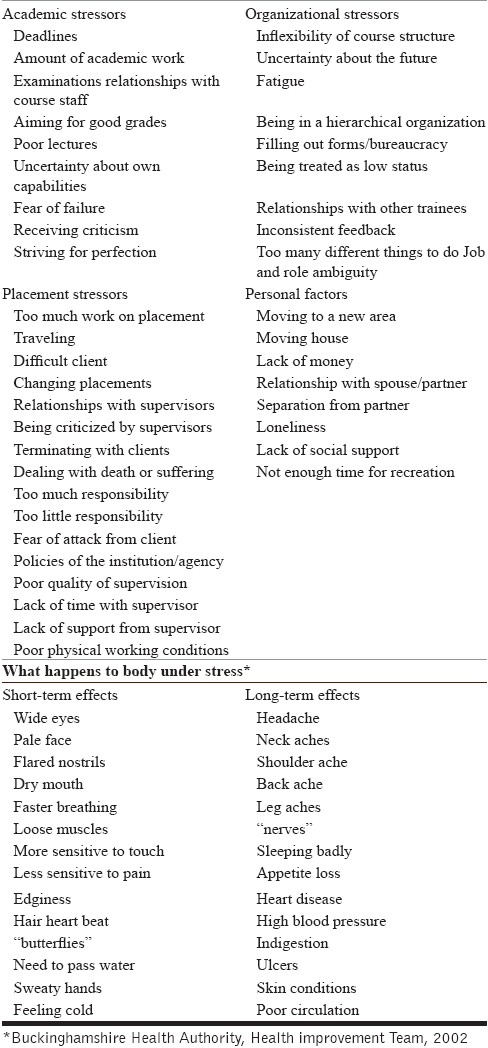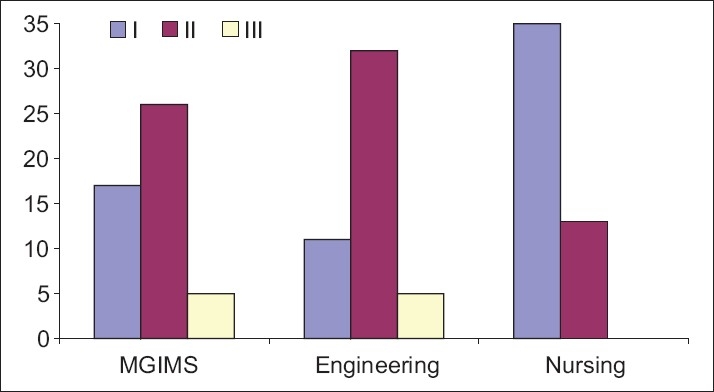Abstract
Background:
In today's ultra competitive environment, students face more stress than ever – be it related to studies, examination, peer, teachers or parent's pressure. Stress is the “wear and tear” our bodies experience as we adjust to our continually changing environment. On one hand, stress compels us to action. However, it can result in feelings of rejection, anger, and depression, leading to health problems such as headaches, upset stomach rashes, insomnia, ulcers, high blood pressure, heart disease, and stroke.
Materials and Methods:
A cross-sectional questionnaire-based survey of 100 randomly selected students each from Medical College Engineering College and 50 Nursing College was done. For reliability, anonymity and confidentiality were maintained. Stress was measured by using stress measurement scale having 24 Yes/No questions. The questionnaire was in English and Hindi so that language would not be problem.
Results:
Stress as an entity is universally present among students of all three streams, irrespective of age, sex, and other variables. Students in all three streams have shown denial to existence of problems, with maximum among nursing students. Medical and Engineering students had stress level of such a degree that requires clinical attention, while none of the nursing students belonged to this category.
Conclusions:
There is attitude among students of turning a blind eye toward existing stress which is a serious problem and may be harbinger of serious mental and psychosocial problems.
Keywords: Profession, stress, students
INTRODUCTION
Nowadays, there is increasing pressure and stress in students. This might be related to studies, examination, peer, teachers or parent's pressure. Stress is difficult to define. Selye originally suggested that stress is simply the rate of wear and tear in the body.[1] Others use the term to refer to the external stimulus that causes wear and tear or to the resulting internal damage, the response. This has led to considerable confusion as Occupational Health has followed the original physics definition where an external stimulus stresses an organism which then feels strain. Psychology, on the other hand, has followed the transactional model which emphasizes intervening psychological processes. In this model, stress is considered only to occur when the person perceives an external demand as extending his or her capability to deal with it. Thus, the individual personal evaluation of the nature of the demand, of the available resources and personal skills, and of the presumed outcomes, will determine whether stress is experienced. This approach both recognizes and deals with individual differences.[2]
The interpretation of what is stressful and the reaction to a source of stress will be different for each of us. Although a model of stress acceptable to everyone has yet to be developed, the diagram below, from Cooper and Eaker, suggests that the process of stress is made up of environmental and individual factors and how they are appraised by the individual.[3]
What is stress?
Stress is the “wear and tear” our bodies experience as we adjust to our continually changing environment; it has physical and emotional effects on us and can create positive or negative influence on us. As a positive influence, stress can help compel us to action. As a negative influence, it can result in feelings of distrust, rejection, anger, and depression, which in turn can lead to health problems such as headaches, upset stomach rashes, insomnia, ulcers, high blood pressure, heart disease, and stroke. With the death of a loved one, the birth of a child, a job promotion, or a new relationship, we experience stress as we readjust our lives. In so adjusting to different circumstances, stress will help or hinder us depending on how we react to it.
So what is stress?
Stress is where a person feels threatened by or under pressure from a particular situation and their body reacts accordingly. Hormones are released to prepare the body for action. The heartbeat increases and blood pressure rises. More blood is sent to the heart and the major muscles and is diverted away from “less important” areas such as the digestive system (hence, the nausea that is often experienced during stress).
The major stressors identified by the respondents of the national survey. Table 1 indicates the variety of all stressors reported by trainees.
Table 1.
Variety of all stressors reported by trainees

Is stress necessary?
A life without any challenge or pressure, i.e., “stress,” would be under stimulating and deadly boring. Everyone needs a certain amount of “pressure” to perform at their best. But when the pressures exceed a person's ability to cope, the result is stress. And, prolonged stress can set up a cycle of distress and cut down the ability to cope with ordinary situations too. Illnesses believed to be caused by stress, if only in part, include angina, asthma, cancer, cystitis, depression, diabetes, diarrheas, heart attack, migraine, psoriasis rheumatoid arthritis, and ulcers. Partial loss of body hair (alopecia areata) or even total loss of all body hair (alopecia universalis) can also result from stress.
Study participants
Hundred undergraduate students of Mahatma Gandhi Institute of Medical Science, Sewagram, Wardha, M.S.
Hundred undergraduate students of B.D. College of Engineering Sewagram, Wardha, M.S.
Fifty B.Sc. Nursing students of Kasturba Nursing College Kasturba Hospital, Sewagram Wardha, M.S.
MATERIALS AND METHODS
Randomly selected 100 students each from medical college, engineering college, and 50 nursing college were given semi-structured proforma to cover sociodemographic variables and details of their perceived stress. For reliability, anonymity and confidentiality were maintained; the students were asked not to write their names. The stress levels were measured by using stress measurement scale having 24 questions with yes/no answers. The questionnaire was in English and Hindi both so that language would not be problem.
RESULTS
Most of the medical students (28 (58%)) were in the age group of less than 20 years, while those of nursing (26 (54.2%)) and Engineering (36 (75%)) were in the age group of 20 to 25 years. Male and female students were approximately equal in sample from medical students. Females dominated nursing sample (44 (91.6%)) while males were predominantly represented in engineering students (34 (70.8%)). All nursing students were higher secondary pass, as were most of medical and engineering students. Also, four medical students and five engineering students had completed graduation before pursuing their respective professional qualifications. None of the nursing students had doctor or engineering as parents. Majority of medical (20 (41.6%)) and engineering (25 (52%)) students had their parents from same profession.
Most of the medical (32 (60.6%)) and engineering (35 (73%)) students had someone as a role model in their choice of particular career and the reverse was true with nursing students (13 (27%)).
As shown in Figure 1, Seventeen medical students and 11 of engineering students showed denial regarding existing stress, while 35 nursing students showed such trait. Twenty-six medical students, 32 engineering students, and 13 nursing students were experiencing normal level of stress and were not blind riding their problems. Five students each from medical and engineering college were having stress of such a degree that requires clinical attention.
Figure 1.

Distribution of denial of stress, normal stress levels, and stress levels requiring clinical attention
DISCUSSION
Stress appears to be universally prevalent entity in all students, regardless of their age, sex, education, parent's occupation, and presence or absence of role model. However, it is apparent that equivalent numbers of medical and engineering students have shown denial to existence of problems, while most of nursing students have shown denial to their problems. This self-defeating attitude of turning blind eye toward existing problems is a harbinger of serious mental and psychosocial problems.[4]
It is also apparent that equal numbers of Medical and Engineering students had stress level of such a degree that requires clinical attention. However, none of the nursing students belonged to this category.
It may be that longer duration of study and greater duration required to complete professional degree, coupled with higher expectations from parents of same background serving as role models,[5] poses a greater degree of stress on medical and engineering students than nursing students.
Otherwise, it may also be said that most nursing students being female have either greater resistance to stress or are faced with less expectations and social pressures than their counterparts. It is also easily discernable that majority of medical and engineering students had parents from same profession, whereas none of the nursing students had such parents. Although having a parent from same profession does have many positive points, negative connotations in the form of expectations by parents from their children to outdo them academically and perform consistently well are enough to burden the students with unwanted stress, in addition to hard labor in studies.[6]
CONCLUSIONS
The attitude among students of turning a blind eye toward existing problems is a harbinger of serious mental and psychosocial problems. It may be that longer duration of study required to complete professional degree, coupled with higher expectations from parents of same background, poses a greater degree of stress on medical and engineering students than nursing students. It is possible that most nursing students being female have greater resistance to stress or are faced with fewer expectations than their counterparts. Although having a parent from same profession does have many positive points, expectations of parents burden the students with unwanted stress, as is evident among Engineering and Medical students.
Clinical implications
If we are able to identify the quality and quantity of stress in medical, engineering, and nursing students, then coping strategies can be adapted which will help in preventing stress-related disorders.
Footnotes
Source of Support: Nil
Conflict of Interest: None.
REFERENCES
- 1.Selye H. Stress. Acta Psychiatr Scand. 1950 [Google Scholar]
- 2.Cox T. Work stress: Nature, history and challenges. Sci Parliam. 2003;60:10–11. [Google Scholar]
- 3.Cooper CL, Cooper RD, Eaker LH. Living with stress. Penguin Books. 1988 [Google Scholar]
- 4.Faber BA. Dysfunctional aspects of the psychotherapeutic role. In: Faber BA, editor. Stress and burn-out in the human service professions. New York: Pergamon; 1983. pp. 97–118. [Google Scholar]
- 5.Nichols K. Practising what we preach. Psychol. 1988;1:50–1. [Google Scholar]
- 6.Guy DJ. New York: John Wiley; 1987. The personal life of the psychotherapist. [Google Scholar]


